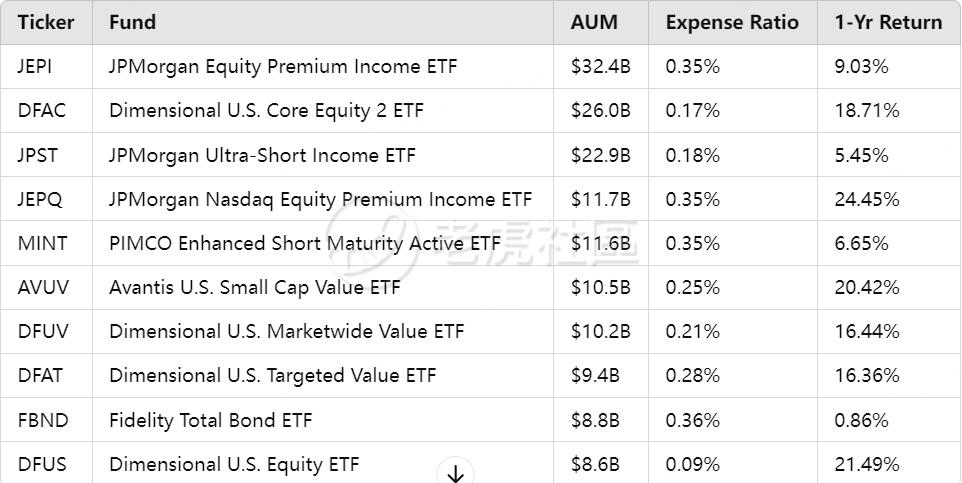Actively Managed ETFs: What Investors Need to Know
Eight of the ten largest active ETFs have outperformed their respective category peers. Actively managed ETFs are booming, with total assets under management now exceeding $600 billion, nearly doubling in the past two years.
In this comprehensive article, we discuss the advantages and disadvantages of active ETFs, compare them to passively managed ETFs, explain the reasons behind their recent growth, and provide a list of the top active ETFs by assets under management (AUM).
What Is an Actively Managed ETF?
An actively managed ETF is an exchange-traded fund overseen by a portfolio manager or team who make investment decisions with the aim of outperforming a specific benchmark or achieving a particular investment objective. This differs from passively managed ETFs, which track a specific index without active trading decisions.
The largest actively managed ETF is the JPMorgan Equity Premium Income ETF (JEPI), with $32 billion in assets as of April 19, 2024. The top ten active ETFs include a mix of equity funds and fixed income funds.
Actively Managed ETFs vs. Passively Managed ETFs
Investment Strategy
Actively Managed ETFs: Managed by professional investment managers who actively select securities for the ETF's portfolio.
Passively Managed ETFs: Track a specific index, with no active trading decisions.
Fees
Actively Managed ETFs: Typically have higher fees due to the resources required for active management and higher trading frequencies.
Passively Managed ETFs: Generally have lower fees as they track an existing index and require fewer resources to manage.
Potential for Returns
Actively Managed ETFs: Can potentially outperform the market if the manager makes better investment decisions, though this is not guaranteed.
Passively Managed ETFs: Designed to match market performance, with no potential to outperform it.
Manager Risk
Actively Managed ETFs: Carry more risk as the manager's decisions can lead to losses if the market moves against their predictions.
Passively Managed ETFs: Less risky as they do not involve active trading decisions.
Top 10 Active ETFs by AUM
Data as of April 19, 2024.
Advantages of Active ETFs
Potential for Outperformance
Active management aims to deliver returns that exceed the benchmark index, leveraging expertise to capitalize on market opportunities.
Flexibility and Risk Management
Managers can adjust the portfolio based on market conditions, allowing them to seize short-term opportunities or avoid specific risks.
Knowledge and Expertise
Professional fund managers conduct in-depth research and analysis to make informed investment decisions.
Customization
Active ETFs can implement specific strategies, such as value investing or sector rotation, tailored to the fund's objectives and manager's expertise.
Tax Efficiency
The ETF creation and redemption process can make active ETFs more tax-efficient than mutual funds. Managers may also employ tax loss harvesting strategies.
Disadvantages of Active ETFs
Higher Costs
Active management incurs higher expense ratios due to extensive research, analysis, and trading activities.
Manager Risk
Not all active managers outperform their benchmarks, and poorly performing ETFs may not justify higher fees. Managers are also prone to behavioral biases.
Daily Disclosure Requirement
Daily disclosure of ETF holdings can make it harder for managers to implement strategies without being front-run by other market participants.
Time and Effort
Investing in active ETFs requires thorough research to evaluate managers' skill and track records, and active monitoring of the fund's performance.
The Booming Growth of Actively Managed ETFs
Active ETF assets have grown significantly, from under $50 billion at the end of 2017 to approximately $340 billion by December 2022. As of April 2023, they held over $605 billion in assets, driven by several trends:
Factor Investing: Focuses on specific factors like value or momentum that predict long-term returns, gaining popularity for improved investment returns.
Thematic Investing: Targets themes such as disruptive innovation or clean energy, appealing to investors seeking exposure to growth trends.
Customization Demand: Investors increasingly seek tailored solutions for their specific needs, and active ETFs offer customizable portfolios.
Bottom Line on Investing in Actively Managed ETFs
Active ETFs provide the potential for skilled management and market outperformance, but they come with higher costs and the risk of underperformance. Investors should carefully consider their investment goals, risk tolerance, and confidence in active management before investing in active ETFs.
$JPMorgan Equity Premium Income ETF(JEPI)$ $Dimensional U.S. Core Equity 2 ETF(DFAC)$ $JPMorgan Ultra-Short Income ETF(JPST)$ $J.P. MORGAN NASDAQ EQUITY PREMIUM INCOME ETF(JEPQ)$ $PIMCO Enhanced Short Maturity Exchange-Traded Fund(MINT)$ $Avantis U.S. Small Cap Value ETF(AVUV)$ $DIMENSIONAL US MARKETWIDE VALUE ETF(DFUV)$ $Dimensional U.S. Targeted Value ETF(DFAT)$ $Fidelity Total Bond ETF(FBND)$ $Dimensional U.S. Equity ETF(DFUS)$
Disclaimer: Investing carries risk. This is not financial advice. The above content should not be regarded as an offer, recommendation, or solicitation on acquiring or disposing of any financial products, any associated discussions, comments, or posts by author or other users should not be considered as such either. It is solely for general information purpose only, which does not consider your own investment objectives, financial situations or needs. TTM assumes no responsibility or warranty for the accuracy and completeness of the information, investors should do their own research and may seek professional advice before investing.


